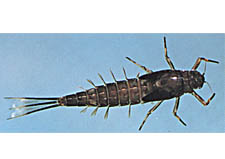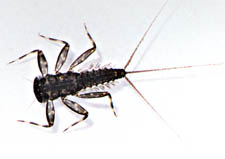
Brown Dun (Ameletus)
Swimming Nymphs
Swimming nymphs inhabit the widest range
of habitats, from slow- to fast-flowing streams and rivers as well as
ponds and lakes. |

Pale Evening Dun (Heptagenia)
Clinger Nymphs
Clinger nymphs live in fast, even turbulent,
waters. They have flat bodies that deflect water flow and strong
legs for clinging to rock surfaces.
|
Looking at the four photographs, there are obvious differences
between the nymphs. The differences are what you need to look
for when buying or tying flies.
Now, how can you tell if there will be a hatch of mayflies? Or
if there isn't a chance of a hatch because the water temperature is
too cold what nymph to use?
In spring, water temperature needs to be in the low 40s. Peak
hatches occur when the water temps hit 46 degrees and up. In
summer, especially evenings, water temp needs to be in the 60
degree minimum. For fall mayflies, peak hatches will happen when
the water temp is over 46 degrees.
Using a stream thermometer to check the water temp should
let you know if there will be a hatch at any particular time. That is
dependent obviously on knowing you have nymphs there. Finding
the nymphs can be as easy as walking along a stream and
reaching into the water and removing a small rock. Turn the rock
over and see who is living on or under it. If it has the general
characteristics of one or more of the nymphs shown in the photos,
your chances are pretty good. You can hedge your odds even more
if you check the nymphs for a little split towards the head on the
insect.
This little split indicates that the wings are developed and
ready. If there are no splits, you probably are stuck with fishing
nymphs. Use a pattern that is as close to the shape, color and size
of the nymphs you find.
Your casting does not have to be great to fish mayfly nymphs.
Since it is a wet fly, a simple roll cast with an upstream mend will
get your fly down to the proper depth.
I personally don't fish nymphs. Yes, there was a time when I
did. As a kid I also fished worms.
Nymphing in America is sort of a chuck and duck thing for
me, not as much fun as fooling a fish on a dry fly. Of course
nymphs work. They catch trout and for some who must have a
number count to have a successful day fishing, it may be the only
way to fish.
Gold-Ribbed Hare's Ear, Bead Head Twist Nymph, Cream
Variant Nymph, Hendrickson Nymph, Pheasant Tail Nymph, are
just a few of the common mayfly nymph patterns.
Unfortunately, nymphing is misused. Numbers are not what fly
fishing is about. The British do fish nymphs. Under very rigid rules.
You only cast a nymph to a visable fish who is nymphing. Never
when fish are rising, and only on designated waters.
As a fly fisher you will make many choices. Choosing to fish
with a particular type of fly as in dry or nymphs is just one of
those choices. Fly fishing is not carved in granite. You can always
change your mind. The choice to fish nymphs is also yours ... as is
the choice not to.
Stop by the Chat Room and meet some fellow anglers. It is a nice
bunch of people - always willing to help new fly fishers! Or just share your
fishing adventures. Fair skys and tight lines, ~ DB
Have a question? Email me!
Beginners Archives
|




